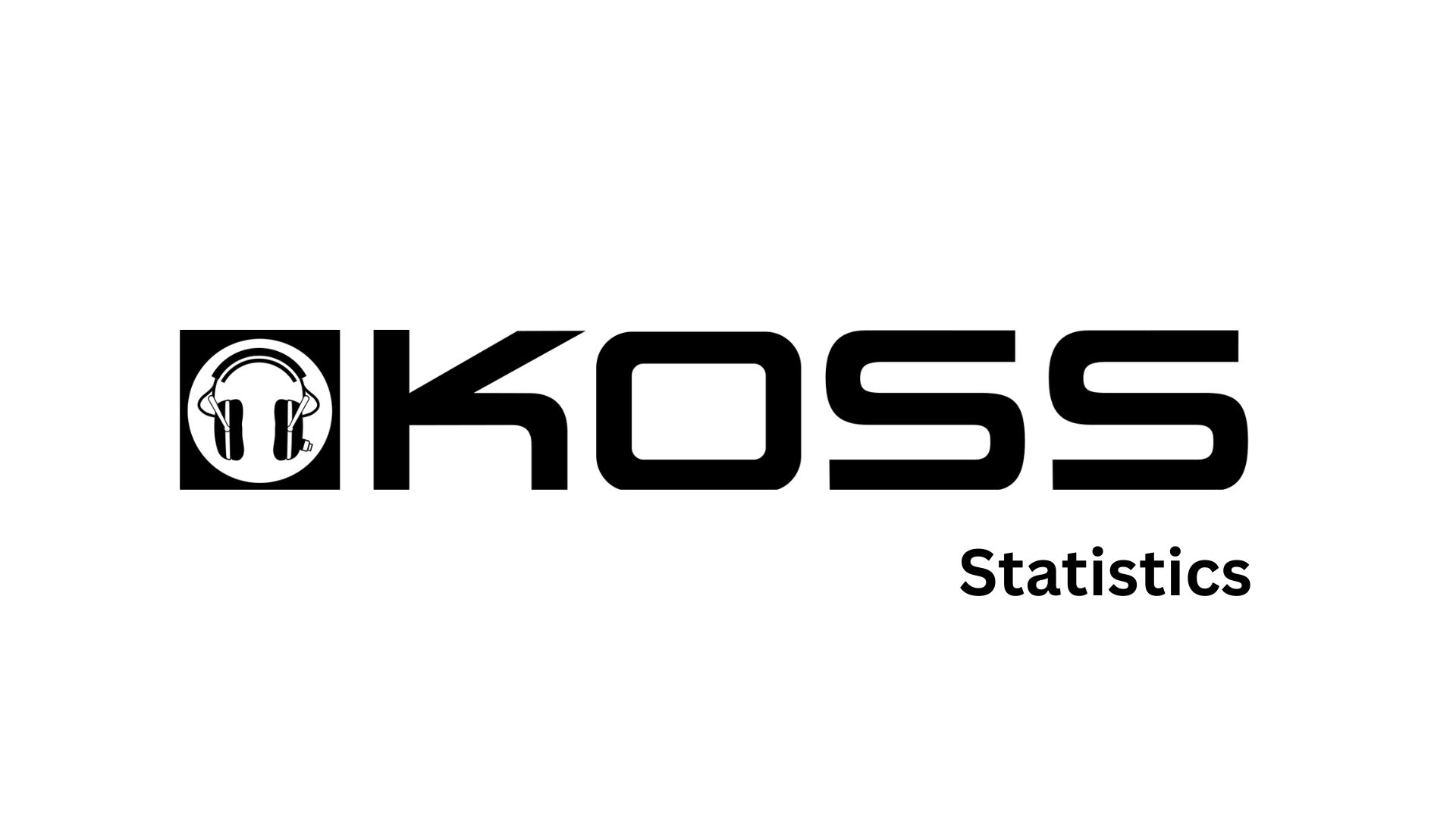Netflix vs Hulu Statistics By Revenue And Subscribers (2025)
Updated · Oct 20, 2025
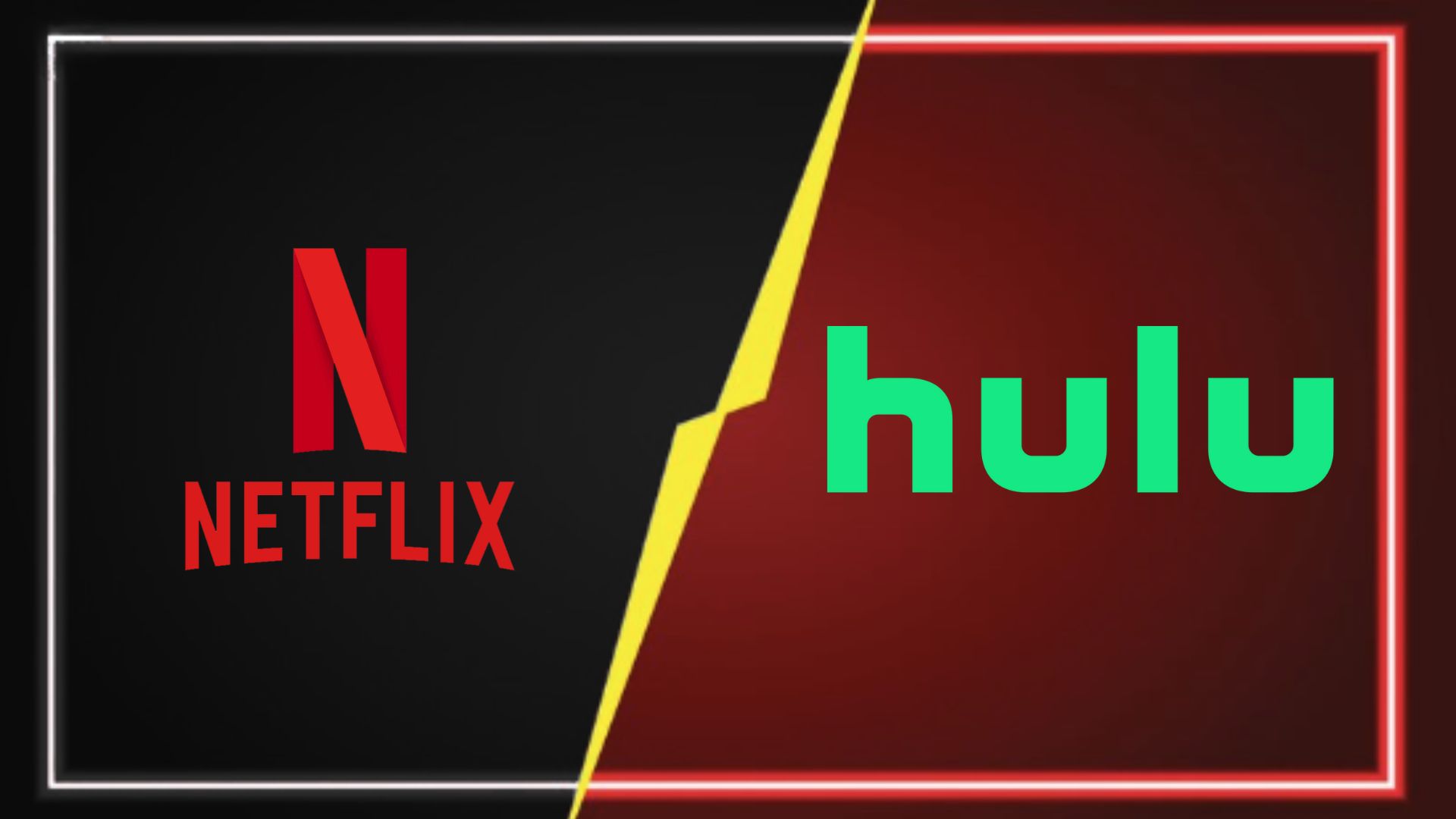
Table of Contents
- Introduction
- Editor’s Choice
- Netflix vs Hulu Revenue Statistics
- Netflix vs Hulu Subscribers
- Netflix vs Hulu Paid Subscribers
- Netflix vs Hulu ARPU
- Netflix vs Hulu Awards
- Netflix vs Hulu Users By Generation
- Netflix vs Hulu Streaming Statistics
- Netflix vs Hulu Streaming Time
- Netflix vs Hulu: Content, Pricing, And Features Compared
- Netflix vs Hulu Market Share
- Conclusion
Introduction
Netflix vs Hulu Statistics: In 2024, Netflix and Hulu were firmly atop the global streaming landscape. While Netflix remains the uncontested global giant, Hulu commands the U.S. territory.
Here is a clear Netflix vs Hulu statistics inspection of their subscriber bases, revenues, market shares, content investments, and major areas of growth through 2024, using simple language allowing clarifications from subscribers that are new to the metrics of streaming industries.
Editor’s Choice
- Netflix earned around US$17 billion from the U.S. and Canada in 2024, with Hulu generating US$12 billion, indicating Hulu’s steady growth domestically and concentrated regional growth for Netflix.
- The platform added 22.4 million new subscribers worldwide from January until September 2024, whereas Hulu increased from 48.2 million to 50.2 million U.S.-only subscribers within that timeframe.
- In paid-subscriber growth, with more than 22 million global users added in the first three quarters of 2024, Netflix was on top during this period, while Hulu was at 54 million U.S. paid users in early 2025, up from 49 million the prior year.
- By 2023, Netflix had increased its global ARPU to US$16.92, far ahead of Hulu’s US$12.52 ARPU in Q1 2025; however, Hulu’s number is impressive, considering it operates solely in the United States.
- Price-wise, Hulu remains flexible in its offering with ad-supported (US$9.99/month), ad-free (US$18.99/month), and Disney bundles, while Netflix goes with tiers without bundling.
- In the arena of awards, Netflix dominated the Golden Globes settings for the 2025 seasons with 23 nominations, against Hulu’s 5, and gave the edge to Netflix, with 24 Emmys won in 2024 as opposed to a lesser handful that Hulu had won, thus reinforcing the strength of Netflix recognition within the industry.
- Netflix has gained increased appeal among Millennials (33%) and Gen Z (18%), whereas Hulu appeals to a broader age range, as seen in 37% for Millennials, 37% for Gen X, and slightly higher among Boomers.
- In 2024 streaming ad time, Hulu ascribed 13%, miles above Netflix’s 3%, giving Hulu the lead in ensconcement in the realms of ad-supported content and Netflix as an entry-level.
- Hulu led the ad time stats, but in total viewership time, Hulu ranked struggling below Netflix, capturing 10% against 16%, while YouTube topped with 21%.
- Netflix reached 71% of U.S. households in 2024, followed by Hulu at 50%, strengthening by virtue of more penetration of Netflix despite it being domestically focused.
Netflix vs Hulu Revenue Statistics
Netflix Revenue

(Reference: statista.com)
Hulu Revenue
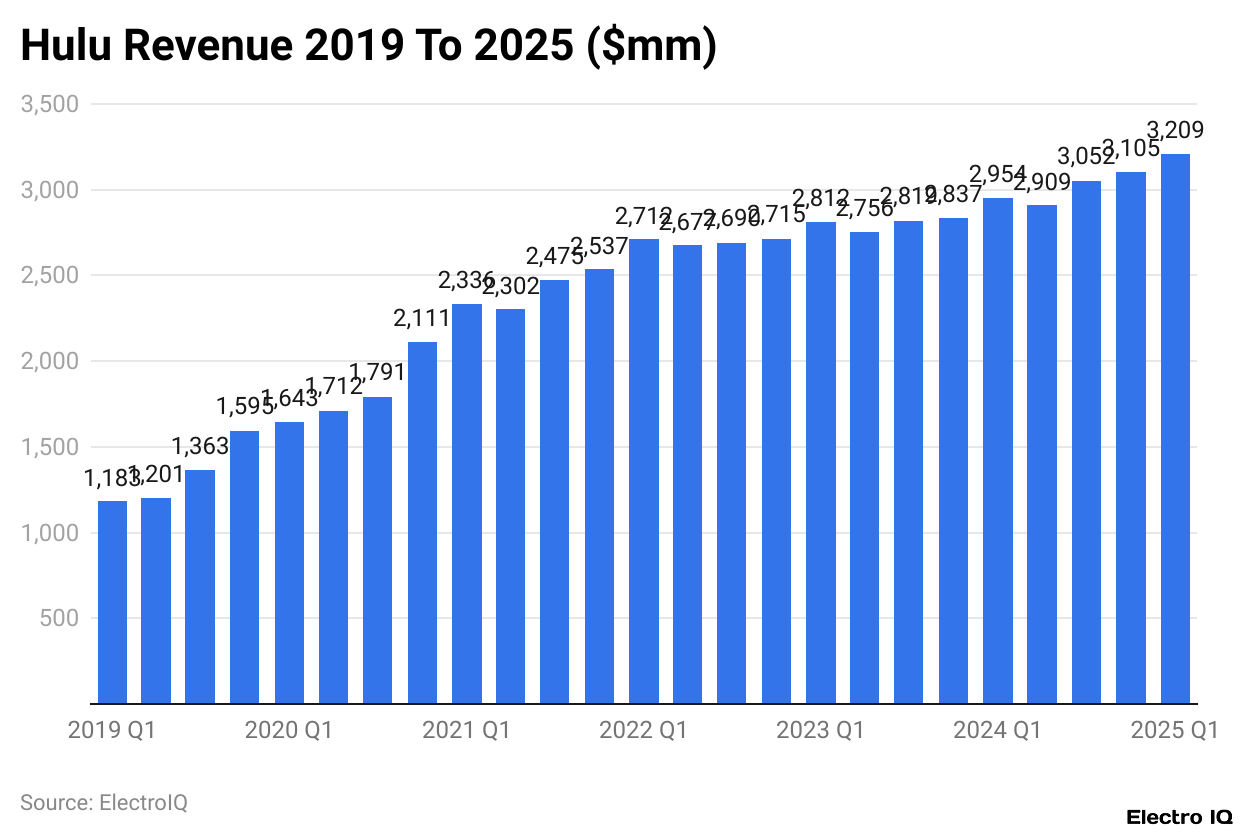
(Reference: businessofapps.com)
- As per a Statists report, Netflix vs Hulu statistics show that in 2024, Netflix revenues garnered from the U.S. and Canada stood at around US$17 thousand, rolling up from about US$15 thousand at the beginning of the year, while Hulu revenues stood steady at the US$12 thousand mark during the sins period, marking steady growth from US$11.2 thousand in 2023.
- Netflix North American revenues stood more than threefold of combined revenues from Latin America and Asia-Pacific, showing stark regional revenue concentration when compared with Hulu’s growth, which has been linear and steady over the years.
- While Netflix faces some hurdles in bearing growth, especially in mature markets like North America, where it also recorded the highest number of subscriber losses in 2022, Hulu took a steady course toward financial momentum.
- Hulu revenues have increased from US$2.4 billion in 2016 to US$3.1 billion in 2017 to US$4.5 billion in 2019 to US$7.2 billion in 2020, when the demand for digital content reached a peak amidst the pandemic.
- Conversely, Netflix showed resilience and global reach by recovering from regional declines with almost 30 million net new subscribers added in a single year, whereas Hulu has mainly been focused within the U.S., with steady growth and strong ad revenues.
- Hulu’s historical revenue data shows a gradual and stable CAGR from US$1.1 billion in 2013 to US$1.6 billion in 2014, eventually crossing the US$2 billion mark in 2015, and moving onward. Netflix, at present, for example, earns significantly more per market, but the consumer perception has taken a hit over the last few years. Satisfaction ratings fell from 90% in 2021 to below 80 % in 2024, and with that went some of the strength of user loyalty.
- The biggest drop between 2021 and 2023 in users who intend to continue their subscriptions was experienced by Netflix, with user sentiment for Hulu having stayed more stable over the years.
Netflix vs Hulu Subscribers
Netflix Subscribers
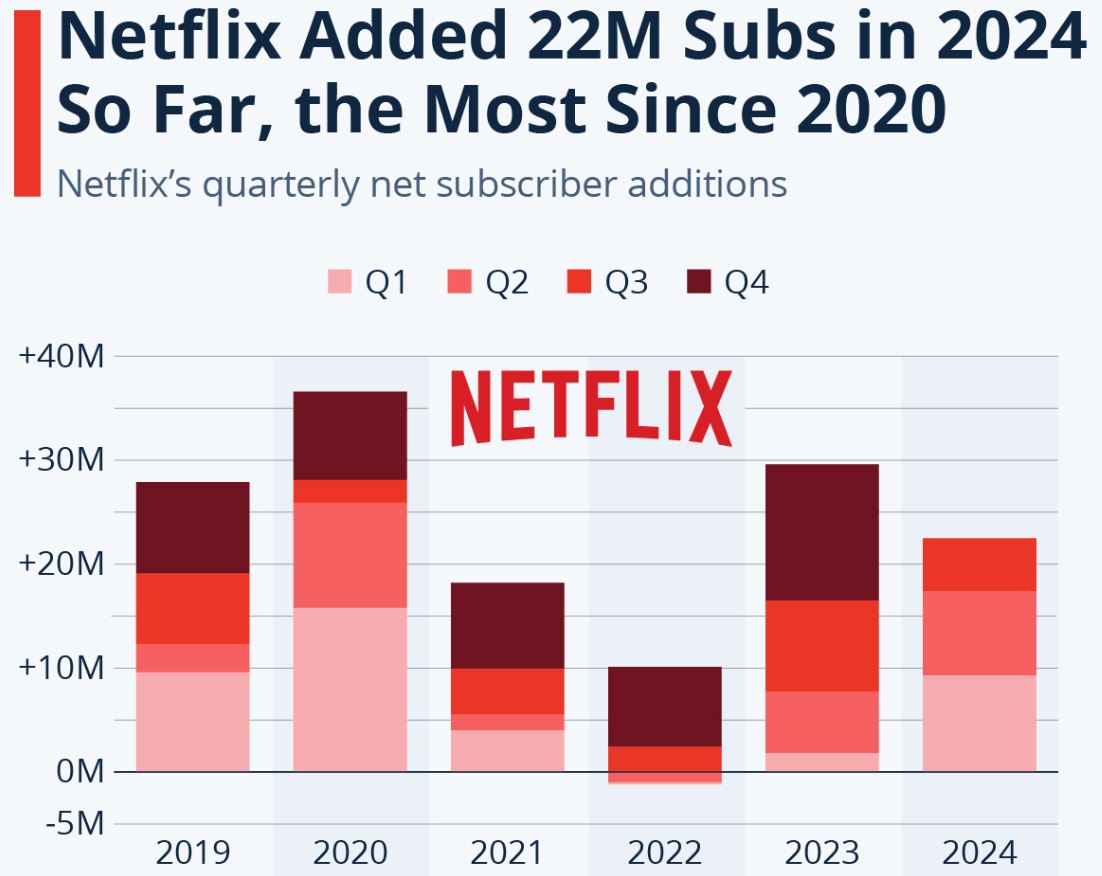
(Source: statista.com)
Hulu Subscribers
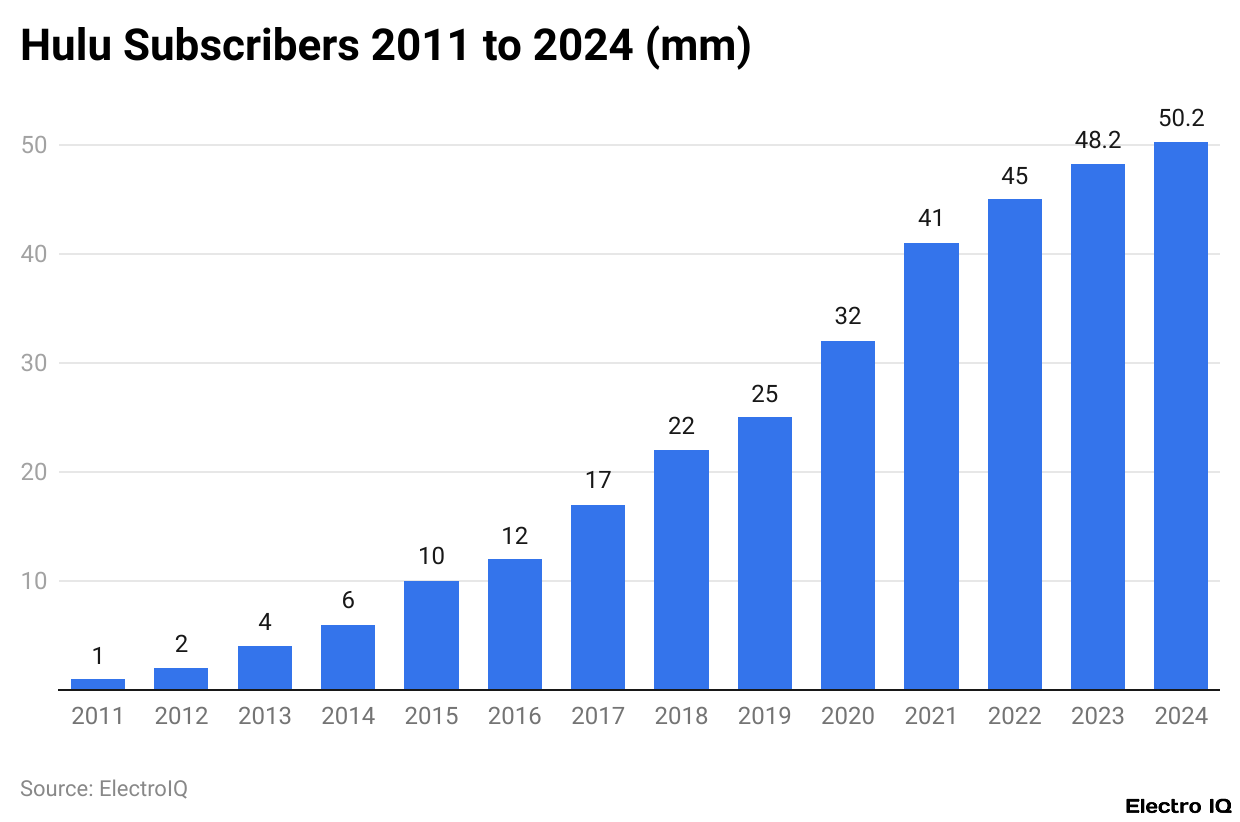
(Reference: businessofapps.com)
- Recently, Statista reported that Netflix vs Hulu statistics reveal that new subscription numbers for Netflix far outran those for Hulu. During the first nine months of 2024, Netflix collected 22.4 million additions to its subscriber list, moving much ahead of the figure of 16.4 million it managed during the same time frame in 2023.
- Meanwhile, Hulu pressed on with its gradual growth from 48.2 million in 2023 and 45 million in 2022 to a total of 50.2 million subscribers in 2024. Netflix had 5.1 million new sign-ups in Q3, beating the expectation of 4.5 million; however, Hulu has enjoyed steadier growth since.
- Netflix reported a revenue jump of 15% year over year in Q3 2024 on the back of membership growth. Hulu, not on the scale of these quarter surges, has remained resilient in the long run, climbing from just 1 million users in 2011 to more than 50 million in 2024.
- Netflix is now doubling down on growing its ad-supported tier, which saw a 35% lift in membership, with over half of the eligible market’s new sign-ups opting into the ad plan.
- While the growth was no longer rapid, with time, Hulu has demonstrated some sustained momentum. The number of its users has grown from 32 million in 2020 to beyond 50 million by 2024.
- Now with double-digit revenue growth expected to continue, Netflix aims to ensure that an ad-based business grows exponentially, along with members having a high average revenue.
- Meanwhile, Hulu benefits from a more consistent growth curve, perhaps even akin to wholesome growth, by getting more subscribers year after year: from 17 million in 2017 to 25 million in 2019 and 41 million in 2021.
- While their attention rests on getting calendars of massive ad subscriber bases by 2025, Hulu continues to grow on top of its refined user base with steady performance and brand allegiance.
Netflix vs Hulu Paid Subscribers
Netflix Paid Subscribers
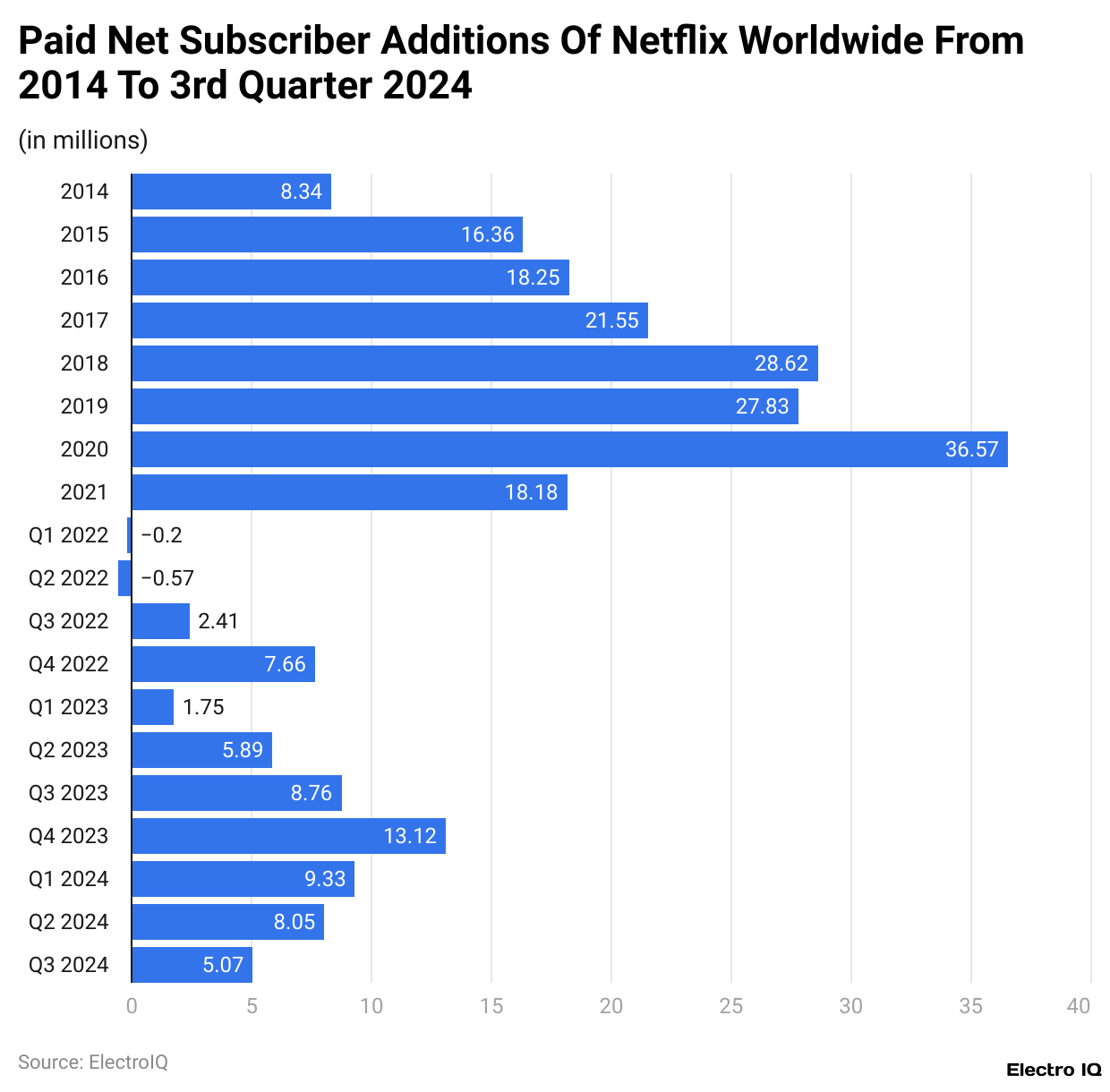
(Reference: businessofapps.com)
Hulu Paying Subscribers
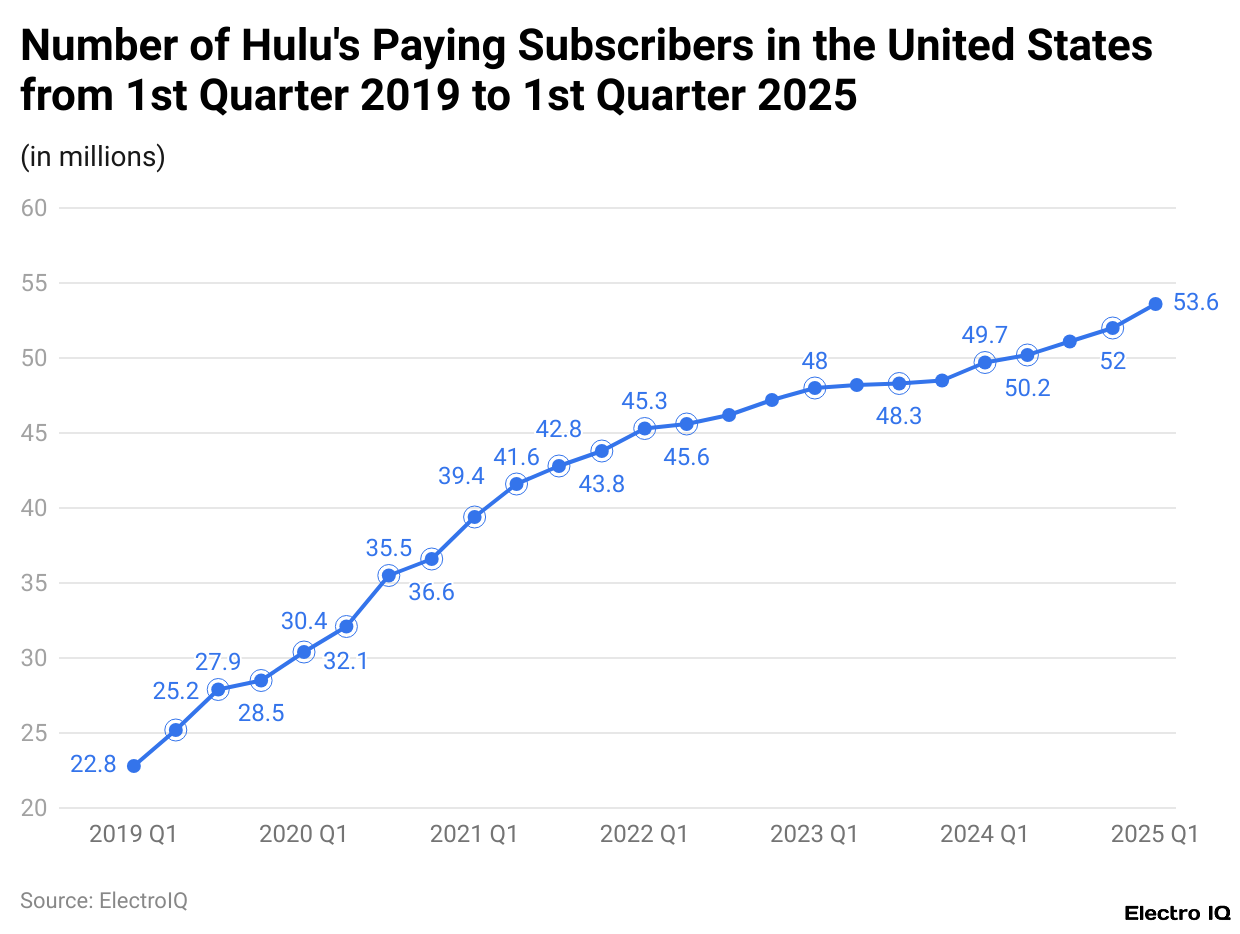
(Reference: statista.com)
- According to a Statista report, Netflix vs Hulu statistics show that starting in 2024, with its earlier lead on Hulu in terms of adding new subscribers, Netflix saw in just one quarter about 9.33 million new subscribers across the globe.
- It capitalises on this momentum well throughout the year, gaining an additional 8.05 million subscribers in the second quarter and another 5.07 million in the third quarter.
- Hulu’s subscription model is purely American; it reported 54 million paid subscribers for the first quarter of 2025 as compared with 49 million subscribers reported during the same fiscal period in the prior year.
- Growth for Netflix is quick and global, whereas Hulu makes steady work at the domestic front. Pricing has been another big distinction.
- Hulu tends to maintain flexibility in its pricing structure by offering different plans that meet the needs of diverse viewers: Ad-supported Basic Plan – US$9.99 per month (October 2024 prices), Ad-free Plan – US$18.99 per month, Bundled Plan including Disney+ and ESPN+ for users who find multi-platform access into value.
- Netflix, on the other hand, has differentiated its pricing structure primarily through its standard, premium, and ad-supported plans, with no option for bundling across services.
- The offerings of Hulu keep it unique from Netflix, with a handful of Hulu originals maturing in culture with The Handmaid’s Tale and Only Murders in the Building, to name a few: as commercialisation shines on the shows, their awards recognition has bestowed a much greater cultural spotlight.
- Globally, Topeka Netflix is renowned for providing a huge catalogue of production partnerships, high-volume mass content strategies, including international hits, and yet iconic live sports experiments.
- For Hulu, its history is marked by changing ownership and strategic realignments. It came into existence in 2007, backed by the biggest media companies, including Disney, Fox, and Comcast, among others, and went through many changes after 2019, with Disney getting the majority of its stake in Hulu.
- In the latter part of the year, AT&T sold back its position of 10%, gaining some more consolidation.
- By November 2023, Disney achieved final acquisition by purchasing Comcast’s remaining 33% stake, resulting in Hulu fully owned by Disney.
- In contrast, Netflix has operated independently, building its unique content pipeline and subscriber base without ever leaning on traditional media company partnerships.
Netflix vs Hulu ARPU
Netflix
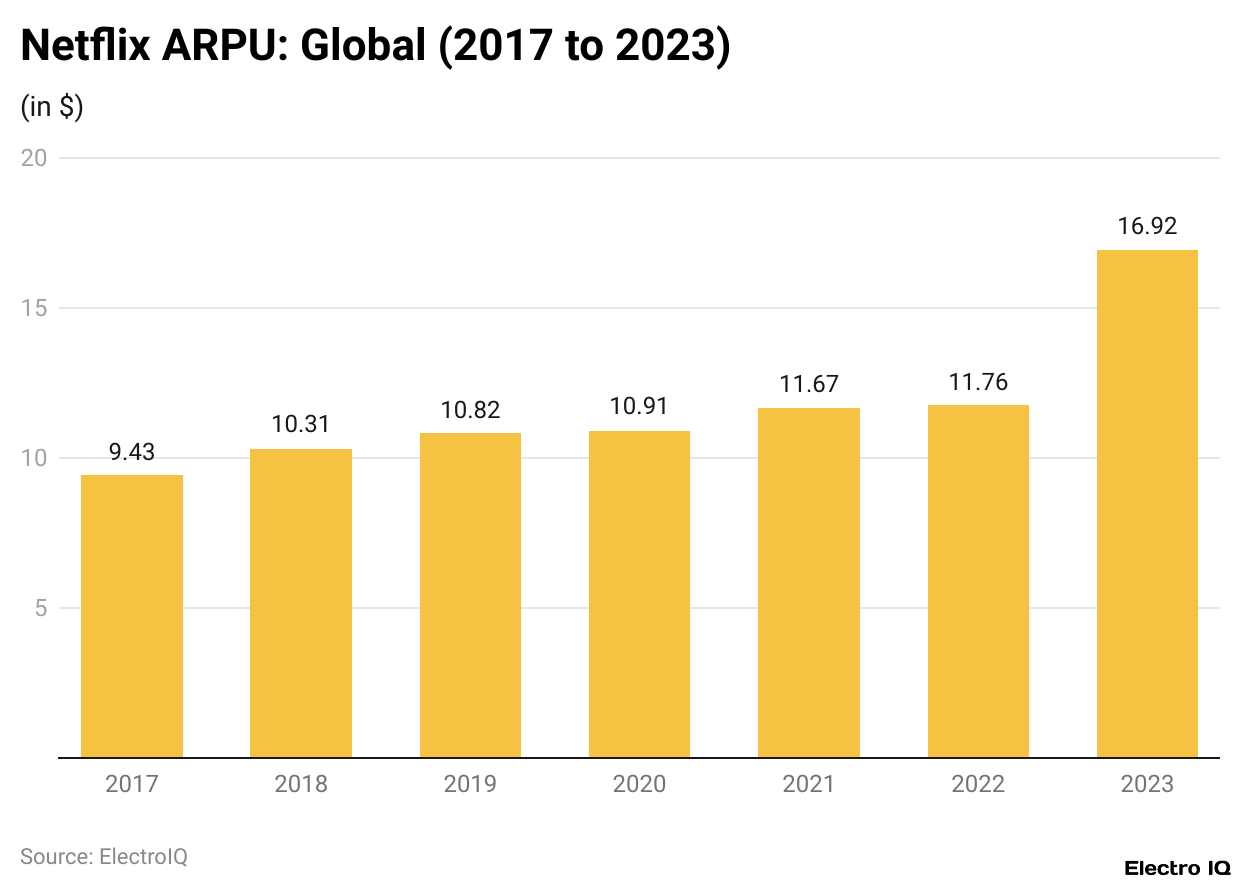
(Reference: helpama.com)
Hulu ARPU

(Reference: statista.com)
- Global average revenue per user (ARPU) for Netflix rose steadily, from US$9,43 in 2017 to US$16,92 in 2023. The ARPU increase marks a sustained trend in price hikes and potentially the adoption of higher-tier subscriptions.
- Netflix shows an almost 80% ARPU rise in the six years, yet the steepest rise was in the 2022-2023 period- the ARPU was US$11.76 in 2022, and in 2023 it shot to US$16.92.
- Compared to this, Hulu was in the first quarter of 2025, onshore with US$12.52 SVOD ARPU, a little bit of increase over US$12.29 in the same quarter of the previous year. Shows a slow, incremental upward trend for Hulu’s ARPU.
- The increase witnessed at Hulu may be slight adjustments in price or increased consumption of premium content.
- Despite this, Netflix’s 2023 ARPU, which by then was more than US$4 ahead of the most recent Hulu ARPU figure, told the story of global stronger monetisation per user by Netflix.
- However, considering Hulu caters solely to the U.S. market and is positioned toward ad-supported and bundle offerings, its ARPU is fairly high.
- While Netflix’s growth in user revenue is quick and evident, Hulu is slowly improving its return on each subscriber through constant platform upgrades.
Netflix vs Hulu Awards
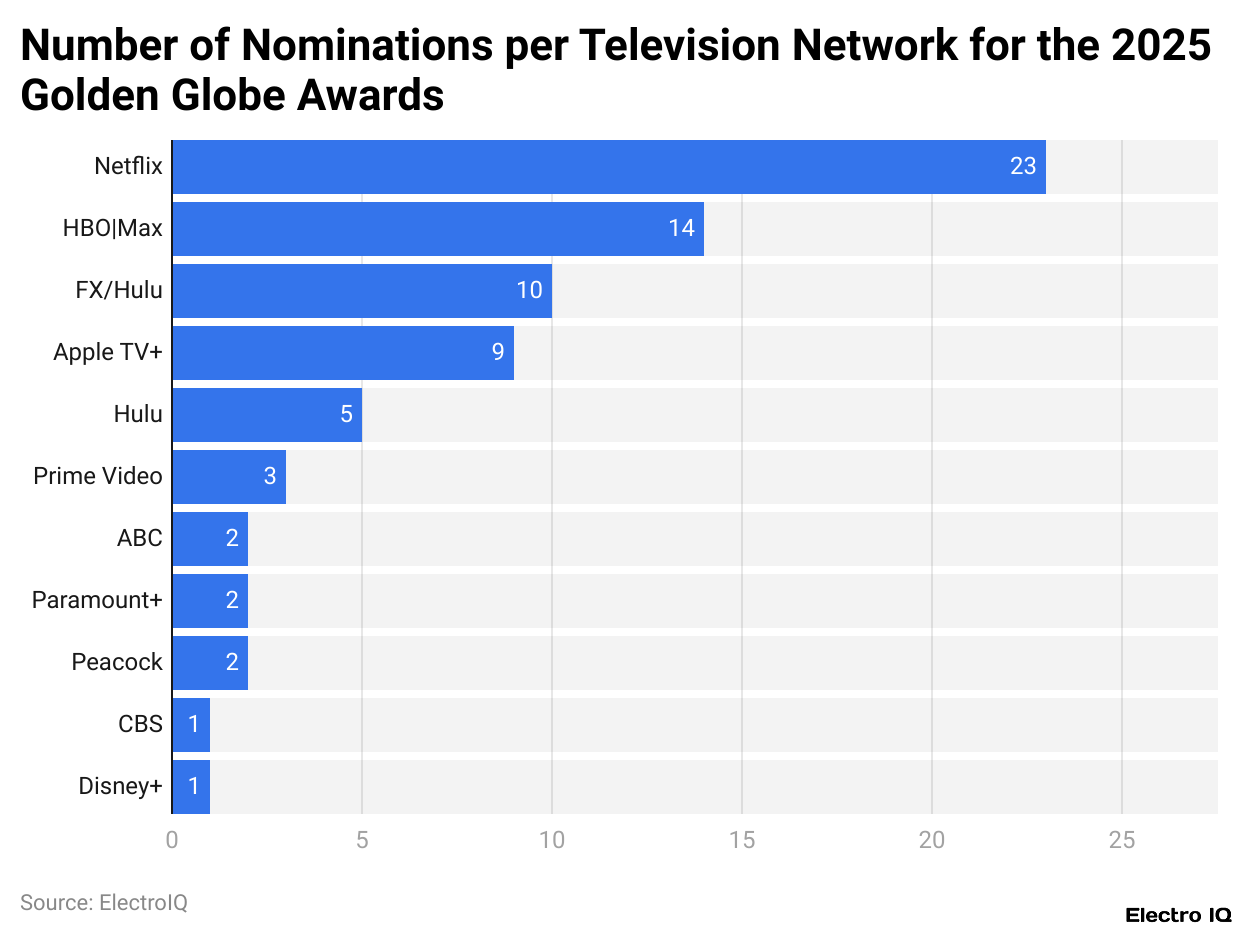
(Reference: statista.com)
- According to a Statista report, Netflix vs Hulu statistics reveal that with 23 nominations at the 2025 Golden Globe Awards, Netflix was recognised as the top among streaming platforms.
- In comparison, HBO and Max accrued 14 nominations between them, far behind Netflix but still ahead of others.
- FX and Hulu compiled 10 nominations between them, with Hulu getting 5 of those, representing half of the total awards.
- Apple TV+ followed with 9 nominations, pointing to its growing clout in premium content.
- Prime Video continued in a distant fifth, with only 3 honours. ABC, Paramount+, and Peacock garnered 2 nominations each, while CBS managed just one, further emphasising the gradual overshadowing of traditional networks by streaming services for award relevance.
- At the Oscars, Netflix climbed to its peak in 2021 with 35 nominations, the most it had ever achieved. However, the number went down to 15 in 2023 and then went back up to 19 in 2024, showing the fluctuation in performance as films vary from season to season in their strength.
- In terms of the Emmy Awards, Netflix showed steady growth: it received 107 nominations in 2024, out of which it won 24 awards, improving over its 2023 performance of 103 nominations and 22 wins.
- The uptrend in nominations and awards paints Netflix as an increasingly dominant and credible entity in the entertainment industry when held against its contemporaries.
Netflix vs Hulu Users By Generation
Netflix Users By Generation
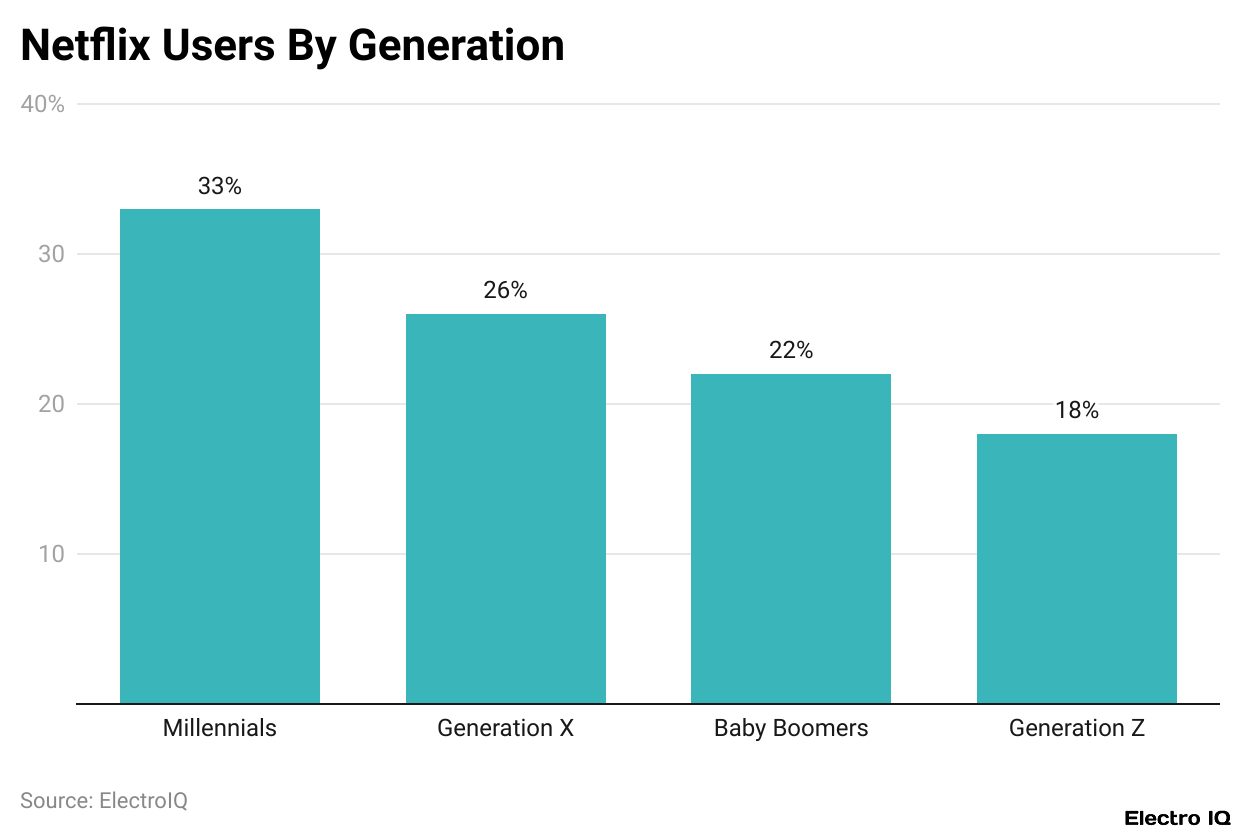
(Reference: demandsage.com)
Hulu Users
| Generation |
Share of Hulu Users
|
| Generation Z | 17% |
| Millennials | 37% |
| Generation X | 37% |
| Baby boomers | 19% |
(Source: backlinko.com)
- According to Demandsage and Backlingo, Netflix vs. Hulu statistics indicate that millennials represent the largest share of Netflix users at 33%, followed closely by Generation X at 26%, Baby Boomers at 22%, and Generation Z at 18%. This suggests that while users from younger generations, especially Millennials, have been a major thrust behind Netflix’s popularity, at the same time, a good majority of users come from the older age groups.
- On the other hand, Hulu has a rather even generational split, with Millennials and Generation X each forming 37% of its users. Generation Z accounts for 17% while Baby Boomers give the platform 19%.
- Compared with Netflix, Hulu holds a little more share from Generation X and Baby Boomer users and thus also appeals to middle-aged and older Americans, with Netflix leaning heavily toward Millennials and younger viewers.
Netflix vs Hulu Streaming Statistics
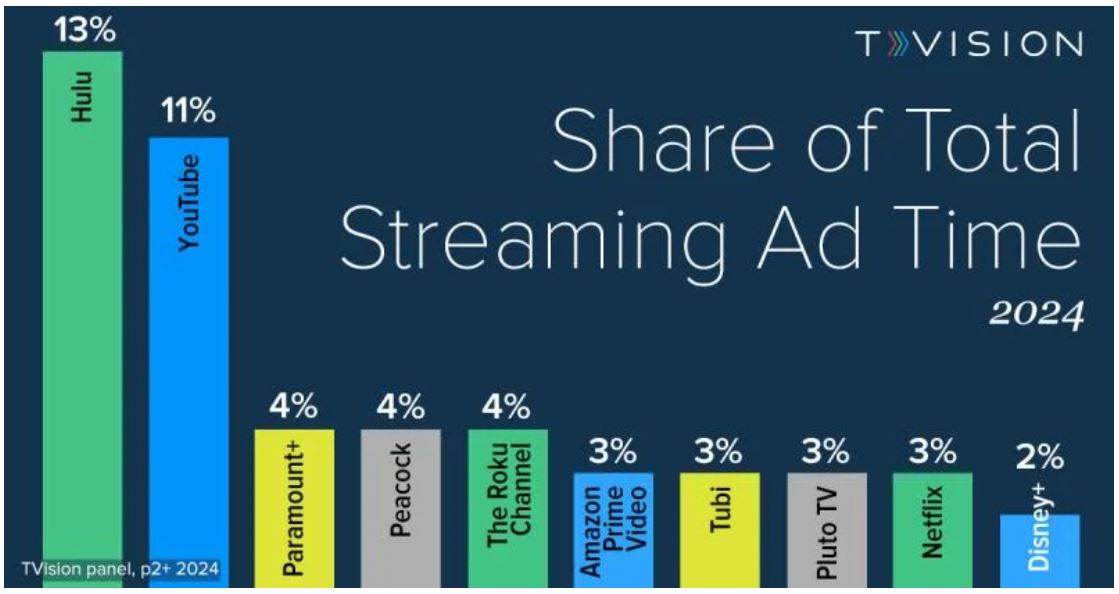
(Source: streamtvinsider.com)
- Hulu took the lead in 2024 with 13% of ad time across AVOD and FAST apps, cementing its position as number one in the streaming ad time share, according to TVision’s State of Streaming report.
- This share had increased by 20% between Q1 and Q4 and was upward throughout the year. Next came YouTube with an 11% share, thus ranking second to Hulu.
- Meanwhile, Netflix decreased significantly in view of ad time, grabbing just 3% of the streaming ad time for the year, ranking ninth among the top ten platforms.
- Though Netflix doubled its ad time share from 1.8% in Q1 to 3.6% in Q4, showing very recently signs of promising acceleration since the ad-supported streaming is new for it, it yet remained behind Paramount+, Prime Video, and FAST platforms like The Roku Channel, Tubi, and Pluto TV-especially since it was clearly better than Disney+, which ranked last.
- This is a clear indication of how mature Hulu is in the space of ad-supported streaming, having offered such plans earlier than both Netflix and Disney+, which only entered late in 2022 with their ad tiers.
- According to TVision’s data, based on a panel of 5,000 U.S. households, Hulu’s strong and growing presence in the ad-supported market greatly favours it over modern contenders like Netflix in this space.
Netflix vs Hulu Streaming Time
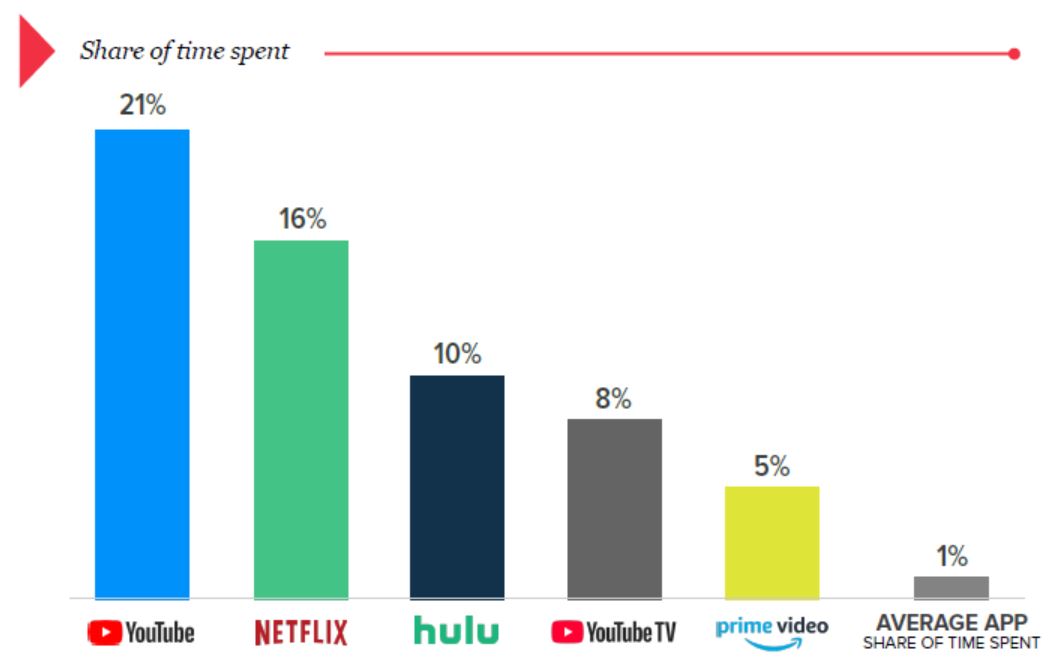
(Source: streamtvinsider.com)
- Ad-supported streaming media had more ad time allotted to it on Hulu in 2024, but it was never the time with the most viewership according to TVision streaming time data.
- Hulu accounted for just 10% of total time spent streaming, behind YouTube with 21% and Netflix with 16%.
- This means that though Hulu maintained a dominant ad-supported position, viewers overall were spending more time in front of YouTube and Netflix.
- In terms of household reach, Hulu is once again coming in third at 50% of U.S. households. For comparison, Netflix could still claim the broadest reach at 71%, and YouTube followed closely with 67%.
- This data shows that Hulu, in terms of ad time, took a front seat but still played a second fiddle to both Netflix and YouTube in absolute viewer time and penetration of households.
Netflix vs Hulu: Content, Pricing, And Features Compared
- Hulu offers a modest amount of originals, with only around 40% being exclusive content. Netflix, meanwhile, offers far more and more exclusives, with 83% of its library being original productions and thus enjoys that clear edge.
- Amazon Prime Video stands sort of above Hulu, with the percentage of original content being 38%.
- Great originals include shows such as The Handmaid’s Tale, Runaways, Normal People, and Veronica Mars from Hulu.
- Both Netflix and Hulu maintain the quality of programming, with shows averaging above an 8.0 rating on IMDb.
- While Prime has the most movies and shows, Hulu lands somewhere between Netflix and Amazon in terms of quality. Prime Video content averages a 7.5 IMDb rating, and Apple TV Plus owns the least number of highly rated titles.
- At least as far as price is concerned, Apple TV Plus is ranked as the least costly major streaming service at a mere $4.99 per month, but with the smallest content library.
- Hulu and Netflix almost go neck-to-neck in terms of price, with Hulu’s ad-free subscription carrying a monthly price of $11.99, while Netflix’s standard HD plan goes for $12.99.
- By contrast, Netflix does not permit any form of add-ons and has no live TV. However, Netflix certainly has an edge when it comes to offline watching; users can download as many as 100 titles, depending not on subscription but just their interest.
- Hulu users are given an option to download only if they subscribe to the ad-free plan, while a maximum of 25 episodes or movies can be downloaded.

(Reference: skillademia.com)
- Netflix vs Hulu statistics represent the percentage share of the viewing time or market share among the major streaming platforms, given by Skilademia.
- Netflix stands far ahead with about 38.6%, signifying that it accounts for the largest portion of streaming activity among the listed services.
- In the middle, Prime Video and HBO stand with 15.9% and 15%, respectively, showing strong engagement but still being far behind Netflix.
- Disney+, with 22.8% shares, walks ahead as a strong contender in the arena, especially in the competition coming from family-friendly and franchise content.
- Hulu, having only 7.6%, lags among this group and accounts for a much smaller amount of viewer engagement compared to others.
Conclusion
Netflix vs Hulu statistics: Netflix is marketed as the worldwide streaming platform, noted in 2024. The combination of being the first to offer ad-supported tiers, a massive content spend, and foraying into live sports broadcasting led to record quarterly growth with higher revenue projections. Hulu, on the contrary, has been growing in the U.S. market, hence swelling its subscriber base and annual revenue.
It is a key player in live TV and SVOD, but with a limited geographic reach. Bundled with Disney+, Hulu’s strategy is one of deep integration and steady audience growth within the U.S. In other words, Netflix is one of the few global players aiming to win on scale, wide content offerings, and new formats such as ads and sports; Hulu stands out as an old reliable in the U.S., especially appealing to viewers who prefer live programming.
The two players continue to evolve through a thriving streaming market, reacting to shifting consumer tastes and competitive pressures.
Sources
FAQ.
Netflix has a far larger global subscriber base, adding 22.4 million new users during the first nine months of 2024 alone. In comparison, Hulu is exclusive to the U.S. and reached 54 million paid subscribers in early 2025, up from 49 million the previous year.
Netflix has an estimated revenue of about $17 billion from the U.S. and Canada, while Hulu’s earnings stand at $12 billion in 2024. Despite an overall larger amount generated by Netflix, Hulu exemplifies consistent domestic growth as well as robust advertising revenues, focusing on the U.S. market.
Hulu occupies the ad-supported streaming space rather well and had a 13% share of streaming ad time in 2024. Netflix, meanwhile, only recently introduced ads and managed to secure 3%, growing steadily, but still cannot rival Hulu’s mature ad infrastructure.
The global Netflix ARPU was $16.92 in 2023, which was much higher than Hulu’s ARPU of $12.52 in Q1 2025. Although there exists a considerable gap in the ARPUs of the two companies, it is noteworthy that Hulu maintains this ARPU, seeing as it operates only in the U.S. with a business focusing significantly on ad-supported and bundle offerings.
As of 2024, the market share for Netflix as a leading streaming service is 38.6% of viewing time. Hulu stands at 7.6% with its strong ad presence and thus ranks below Netflix, Disney+ (22.8%), Prime Video (15.9%), and HBO (15%).

Maitrayee Dey has a background in Electrical Engineering and has worked in various technical roles before transitioning to writing. Specializing in technology and Artificial Intelligence, she has served as an Academic Research Analyst and Freelance Writer, particularly focusing on education and healthcare in Australia. Maitrayee's lifelong passions for writing and painting led her to pursue a full-time writing career. She is also the creator of a cooking YouTube channel, where she shares her culinary adventures. At Smartphone Thoughts, Maitrayee brings her expertise in technology to provide in-depth smartphone reviews and app-related statistics, making complex topics easy to understand for all readers.

